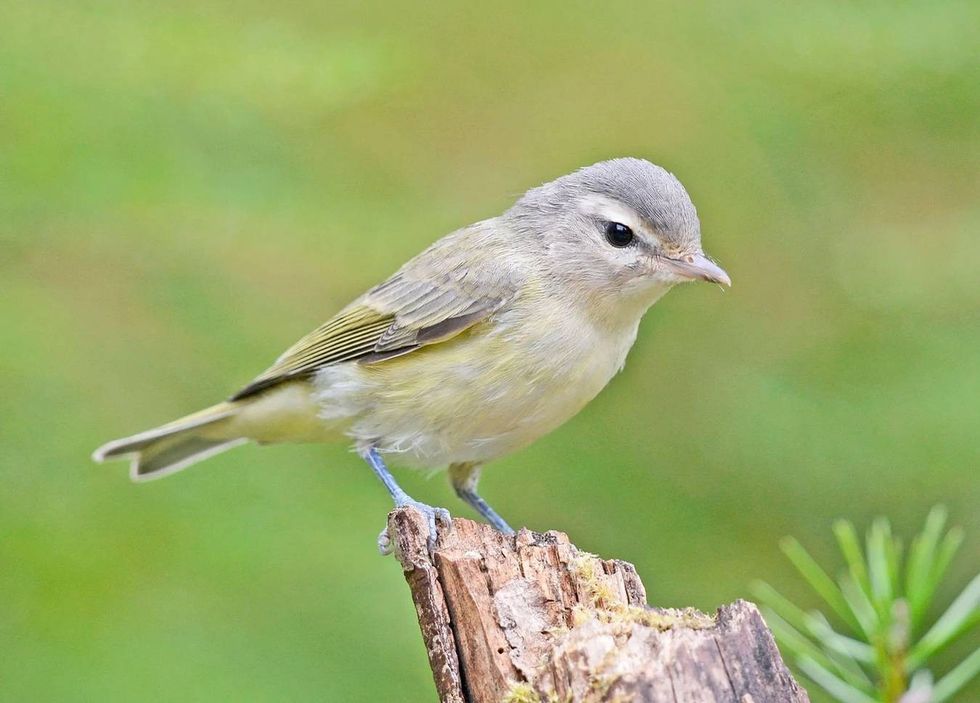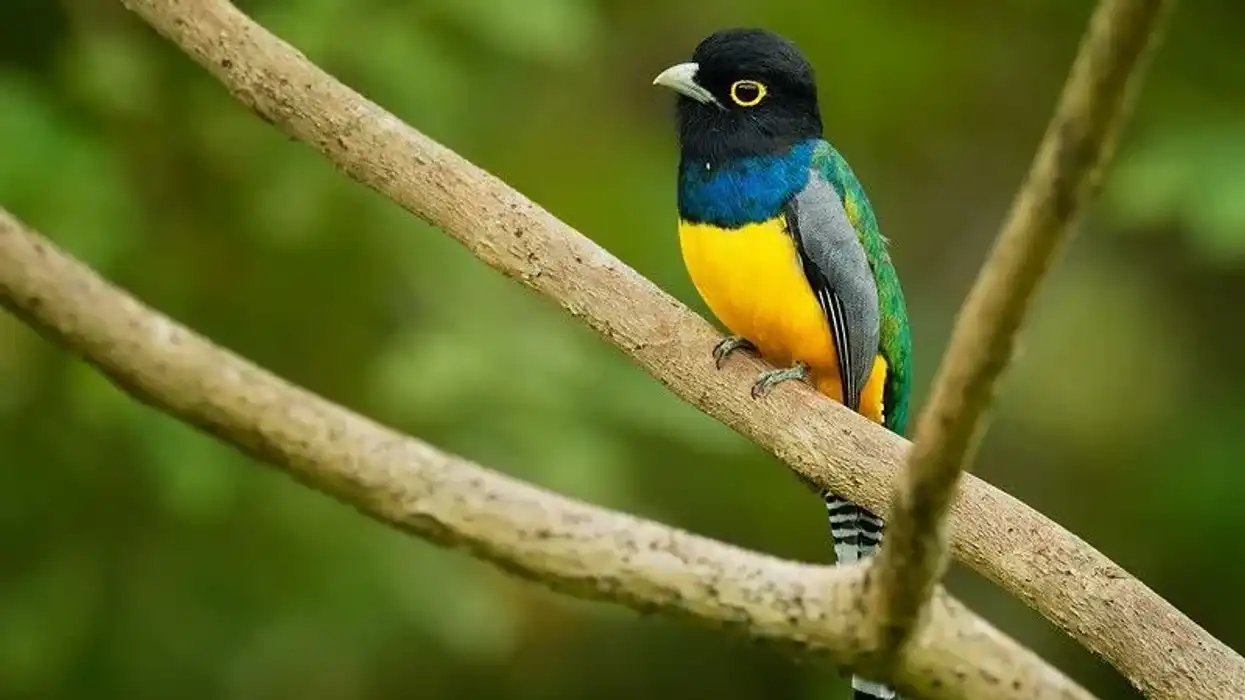Warbling vireos (Vireo gilvus) are tiny, North American songbirds that can be found foraging in forests and woodlands. They belong to the Vireonidae family, order Passeriformes, and genus Vireos.
They have distinctive calls, and their rollicking calls can be heard in Alaska, Mexico, and Florida. They nest alongside streams and migrate to Mexico and Central America.
Their song is short and only lasts for three seconds which is mostly cheery. Though their conservation status is listed as Not Extinct, their population has been recorded to decrease in North America for the last two decades.
When you compare the Philadelphia vireo and the warbling vireo, it is evident that the Philadelphia vireo has a shorter bill, a more rounded head, a more pot-bellied appearance, and a shorter tail. After reading these interesting warbling vireo facts, do check our other articles on the Blackburnian warbler and the blue-winged teal.
Warbling Vireo Interesting Facts
What type of animal is a Warbling Vireo?
The warbling vireo is a songbird belonging to North America. This species of bird is found in dense forests foraging in branches and tall trees. Their calls or songs are short in length and often have a fast pace.
What class of animal does a Warbling Vireo belong to?
Warbling vireos belong to the class of Aves native to North America. These North American birds are migratory songbirds who prefer deciduous or mixed forests for breeding. Warbling vireos are very tiny and mostly inhabit open woodlands.
How many Warbling Vireos are there in the world?
The exact number of warbling vireos is currently unknown, but their conservation status is classed as of Least Concern. Their population has seen a great decline in the last twenty years in California, but they cannot be listed as endangered or a near-threatened species.
Where does a Warbling Vireo live?
Warbling vireos are mostly found in the woods. They can be found throughout summer on tree tops of coniferous and deciduous forests. These North American birds remain to forage on twigs and branches of trees which are at a height of up to 140 feet above the ground.
What is a Warbling Vireo's habitat?
A warbling vireo nest or habitat is any woodland that is dense, coniferous, deciduous, or mixed. They can also be found in thickets and shrublands and in regions where the vegetation is abundant.
They live and habitat in the Nearctic and Neotropical regions, covering the majority of North and South America. The warbler's migration occurs and varies from place to place.
Who do Warbling Vireos live with?
Warbling vireos may sometimes be seen in migration with flocks, but some can also prefer being solitary. These solitary birds then join flocks of mixed bird species consisting of 10 different species of birds. The warbling vireo is a social bird and nests in dense forests with other birds.
How long does a Warbling Vireo live?
The warbling vireo has an average life expectancy of 13-15 years. These nesting birds can live their entire lifespan in their preferred habitats but can be hunted down by other carnivorous birds like hawks and eagles.
How do they reproduce?
Young warbling vireos reproduce through sexual reproduction. There can only be one to two broods per year and season. The breeding season starts in April or May and continues till August.
The pairs start preparing their nest around two to seven days after arriving at their breeding grounds. The clutch size of Warbling Vireo is three to five eggs per litter.
They breed in deciduous and mixed forests. The incubation period lasts for 10-12 days, and they mostly feed on insects and caterpillars. The female Warbling Vireo selects the nesting site and gives birth to a young warbler.
What is their conservation status?
The conservation status of young warbling vireo is of low concern, and their population is widespread in America but hardly any warbling vireo nesting sites are spotted. The warbling vireo population is also decreasing due to the loss of habitat and collision with tall towers.
Warbling Vireo Fun Facts
What do Warbling Vireos look like?

Warbling vireos are plain gray songbirds found mostly in Northern America. They have an overall olive-gray plumage with a white underbody. Vireos have a black line through the eye and a white line over the eye. Their eyes are red and they are yellow-throated.
How cute are they?
Adult warblers are not very cute or appealing. They have tiny gray bodies and can be spotted throughout summer in oak trees or aspen forests. An adult warbling vireo song is quite delightful.
How do they communicate?
Adult warblers communicate through songs and short calls, which only last for three seconds. Female adults have a courtship call which they utter during the breeding season. They sometimes have a spitting call or a raspy, scolding call. They also communicate through body displays but mostly use vocals.
How big is a Warbling Vireo?
They are very little birds of North America and have an average weight of 0.4-0.6 oz (10-16 g) and their body length is 4.7-5.1 in (12-13 cm).
How fast can a Warbling Vireo fly?
The adult warbling vireos often collide with tall builds and die, which means that they fly at a fast pace. They also hunt their prey midair and also through stalking, hawking, and hovering.
How much does a Warbling Vireo weigh?
The average weight of an adult male warbling vireo is 0.30-0.62 lb. They are very few and can be easily spotted foraging in forests that are dense and could provide a cover for hiding.
What are the male and female names of the species?
There are no distinctive names for the adult male and female species of warbling vireo. They are commonly differentiated based on their sexes and are known as male warbling vireos and female warbling vireos.
What would you call a baby Warbling Vireo?
A baby warbling vireo is known as a hatchling or nestling and does not have a different name.
What do they eat?
Warbling vireos are typically insectivores, they eat beetles, wasps, bugs, scaled insects, caterpillars, dragonflies, aphids, ants, spiders, snails, and flies. They also eat berries and seeds.
Are they dangerous?
Species in this family are not at all dangerous and are spotted throughout the entire summer. Humans can pose a danger to their breeding due to increased activity in the forest and clearing forest lands where warbling vireo's nests can be found. They often collide with tall towers and buildings and die.
Would they make a good pet?
No, Warbling Vireos should not be kept as pets. They should be left in the wild as their preferred habitat is deciduous, oak, or mixed forests. They feed on all insects and worms. They also eat seeds and berries. They are social birds and nest with their same species or get mixed with flocks of other birds.
Did you know...
The brown-headed cowbird does not build its nests and lays its eggs in a warbling vireo's nest during the breeding season.
The Warbling Vireo's Call
A warbling vireo's call is raspy or rollicking. The calls of warbling vireos can be solid and cheery and can be used for courtship by females for attracting males. The females also tend to sing a duet with the male.
Threats To The Warbling Vireo
Warbling vireos can collide with tall towers or can be hunted down by predators. Their population is also decreasing due to habitat loss and degradation, and climate change.
Here at Kidadl, we have carefully created lots of interesting family-friendly animal facts for everyone to discover! Learn more about some other birds including the palm warbler and the little blue heron.
You can even occupy yourself at home by drawing one of our Warbling Vireo coloring pages.










